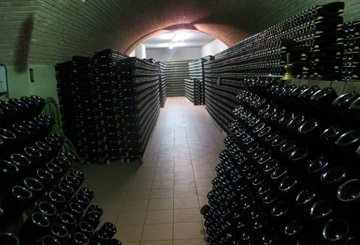Wineries
Kaltern an der Weinstraße/Caldaro sulla Strada del Vino, Alto Adige Wine Road
Up until 1932, there were no fewer than five wineries in the winegrowing village of Caldaro. United under the umbrella of the Cantina Kaltern since 2016, the 590 members of the cooperative tend grape growing areas of 440 hectares and now produce around 4 million bottles of wine per year.
“Our cooperative is one big family,” emphasizes Christian Sinn, general manager of the Cantina Kaltern. “It holds together the many small family winegrower structures, guarantees quality and safety, and gives its members the opportunity of participating in something great.” Bringing forth this “greatness” is a complex undertaking. It is necessary to coordinate all of the members from the pruning of the vines to education and training and to commit them to the winery’s quality policy. That, in turn, includes having to establish and inspect the yield goals for around two thousand plots.
All of that in order to create the best conditions for the best wines. Within that context, the production supports above all else five leading varieties. These are – hardly astonishing – Schiava in the form of Lago di Caldaro, Pinot Blanc, Sauvignon Blanc, Cabernet Sauvignon, and Yellow Muscat for the noble sweet Passito.
But it doesn’t matter which wines are being made or which grape varieties are being grown. For the Cantina Kaltern, the uppermost maxim that is followed both in the vineyard and the winery is sustainability. Thus the winery is the first wine producer in Italy and the first cooperative anywhere to be awarded with the Certification of Sustainability by FAIR ‘N GREEN. And with around 15 hectares that are managed biodynamically, the Cantina Kaltern has also taken on the role of forerunner in this area among cooperative wineries.
“Our cooperative is one big family,” emphasizes Christian Sinn, general manager of the Cantina Kaltern. “It holds together the many small family winegrower structures, guarantees quality and safety, and gives its members the opportunity of participating in something great.” Bringing forth this “greatness” is a complex undertaking. It is necessary to coordinate all of the members from the pruning of the vines to education and training and to commit them to the winery’s quality policy. That, in turn, includes having to establish and inspect the yield goals for around two thousand plots.
All of that in order to create the best conditions for the best wines. Within that context, the production supports above all else five leading varieties. These are – hardly astonishing – Schiava in the form of Lago di Caldaro, Pinot Blanc, Sauvignon Blanc, Cabernet Sauvignon, and Yellow Muscat for the noble sweet Passito.
But it doesn’t matter which wines are being made or which grape varieties are being grown. For the Cantina Kaltern, the uppermost maxim that is followed both in the vineyard and the winery is sustainability. Thus the winery is the first wine producer in Italy and the first cooperative anywhere to be awarded with the Certification of Sustainability by FAIR ‘N GREEN. And with around 15 hectares that are managed biodynamically, the Cantina Kaltern has also taken on the role of forerunner in this area among cooperative wineries.



































